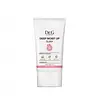What's inside
What's inside
 Key Ingredients
Key Ingredients

 Benefits
Benefits

 Concerns
Concerns

 Ingredients Side-by-side
Ingredients Side-by-side

Water
Skin ConditioningEthylhexyl Methoxycinnamate
UV AbsorberButylene Glycol
HumectantEthylhexyl Salicylate
UV AbsorberAlcohol
AntimicrobialC12-15 Alkyl Benzoate
AntimicrobialDiethylamino Hydroxybenzoyl Hexyl Benzoate
UV FilterHomosalate
Skin ConditioningOctocrylene
UV AbsorberCI 77891
Cosmetic Colorant1,2-Hexanediol
Skin ConditioningNiacinamide
SmoothingCetyl Ethylhexanoate
EmollientC20-22 Alkyl Phosphate
EmulsifyingC20-22 Alcohols
Emulsion StabilisingCaprylyl Methicone
Skin ConditioningGlyceryl Stearate
EmollientBehenyl Alcohol
EmollientSilica
AbrasiveAluminum Stearate
Cosmetic ColorantSodium Acrylate/Sodium Acryloyldimethyl Taurate Copolymer
Emulsion StabilisingTromethamine
BufferingPolyhydroxystearic Acid
EmulsifyingPolyisobutene
Propanediol
SolventPolyacrylate Crosspolymer-6
Emulsion StabilisingAlumina
AbrasiveGlyceryl Caprylate
EmollientSaccharide Hydrolysate
HumectantEthylhexylglycerin
Skin ConditioningOctyldodecanol
EmollientXanthan Gum
EmulsifyingCitrus Aurantium Bergamia Fruit Oil
MaskingOlea Europaea Oil Unsaponifiables
Skin ConditioningPelargonium Graveolens Flower Oil
MaskingAdenosine
Skin ConditioningTriticum Vulgare Germ Oil Unsaponifiables
EmollientSorbitan Oleate
EmulsifyingCaprylyl/Capryl Glucoside
CleansingGlycine Soja Oil Unsaponifiables
EmollientCurcuma Longa Root Extract
MaskingPortulaca Oleracea Extract
Skin ConditioningCentella Asiatica Extract
CleansingEchium Plantagineum Seed Oil
Skin ConditioningHouttuynia Cordata Extract
Skin ConditioningSalvia Hispanica Seed Extract
EmollientSodium Hyaluronate
HumectantPollen Extract
EmollientSalvia Officinalis Oil
MaskingT-Butyl Alcohol
PerfumingPogostemon Cablin Leaf Oil
MaskingCardiospermum Halicacabum Flower/Leaf/Vine Extract
Skin ConditioningHelianthus Annuus Seed Oil Unsaponifiables
EmollientCeramide NP
Skin ConditioningCholesterol
EmollientHydroxypropyltrimonium Hyaluronate
Hydrolyzed Hyaluronic Acid
HumectantCaprylic/Capric Triglyceride
MaskingTocopherol
AntioxidantLinoleic Acid
CleansingGlycine Soja Sterols
EmollientPhospholipids
Skin ConditioningBiosaccharide Gum-4
Skin ConditioningPinus Pinaster Bark Extract
AntioxidantWater, Ethylhexyl Methoxycinnamate, Butylene Glycol, Ethylhexyl Salicylate, Alcohol, C12-15 Alkyl Benzoate, Diethylamino Hydroxybenzoyl Hexyl Benzoate, Homosalate, Octocrylene, CI 77891, 1,2-Hexanediol, Niacinamide, Cetyl Ethylhexanoate, C20-22 Alkyl Phosphate, C20-22 Alcohols, Caprylyl Methicone, Glyceryl Stearate, Behenyl Alcohol, Silica, Aluminum Stearate, Sodium Acrylate/Sodium Acryloyldimethyl Taurate Copolymer, Tromethamine, Polyhydroxystearic Acid, Polyisobutene, Propanediol, Polyacrylate Crosspolymer-6, Alumina, Glyceryl Caprylate, Saccharide Hydrolysate, Ethylhexylglycerin, Octyldodecanol, Xanthan Gum, Citrus Aurantium Bergamia Fruit Oil, Olea Europaea Oil Unsaponifiables, Pelargonium Graveolens Flower Oil, Adenosine, Triticum Vulgare Germ Oil Unsaponifiables, Sorbitan Oleate, Caprylyl/Capryl Glucoside, Glycine Soja Oil Unsaponifiables, Curcuma Longa Root Extract, Portulaca Oleracea Extract, Centella Asiatica Extract, Echium Plantagineum Seed Oil, Houttuynia Cordata Extract, Salvia Hispanica Seed Extract, Sodium Hyaluronate, Pollen Extract, Salvia Officinalis Oil, T-Butyl Alcohol, Pogostemon Cablin Leaf Oil, Cardiospermum Halicacabum Flower/Leaf/Vine Extract, Helianthus Annuus Seed Oil Unsaponifiables, Ceramide NP, Cholesterol, Hydroxypropyltrimonium Hyaluronate, Hydrolyzed Hyaluronic Acid, Caprylic/Capric Triglyceride, Tocopherol, Linoleic Acid, Glycine Soja Sterols, Phospholipids, Biosaccharide Gum-4, Pinus Pinaster Bark Extract
Water
Skin ConditioningCyclopentasiloxane
EmollientZinc Oxide
Cosmetic ColorantPropanediol
SolventTitanium Dioxide
Cosmetic ColorantButylene Glycol Dicaprylate/Dicaprate
EmollientLauryl Polyglyceryl-3 Polydimethylsiloxyethyl Dimethicone
Skin ConditioningMethyl Methacrylate Crosspolymer
Butyloctyl Salicylate
Skin ConditioningCaprylyl Methicone
Skin ConditioningCitrus Aurantium Dulcis Oil
MaskingCitrus Nobilis Peel Oil
MaskingLitsea Cubeba Fruit Oil
Masking1,2-Hexanediol
Skin ConditioningDisteardimonium Hectorite
StabilisingMagnesium Sulfate
Stearic Acid
CleansingAluminum Hydroxide
EmollientPolyglyceryl-3 Polydimethylsiloxyethyl Dimethicone
Skin ConditioningTriethoxycaprylylsilane
Sorbitan Caprylate
EmulsifyingGlyceryl Caprylate
EmollientEthylhexylglycerin
Skin ConditioningTocopherol
AntioxidantWater, Cyclopentasiloxane, Zinc Oxide, Propanediol, Titanium Dioxide, Butylene Glycol Dicaprylate/Dicaprate, Lauryl Polyglyceryl-3 Polydimethylsiloxyethyl Dimethicone, Methyl Methacrylate Crosspolymer, Butyloctyl Salicylate, Caprylyl Methicone, Citrus Aurantium Dulcis Oil, Citrus Nobilis Peel Oil, Litsea Cubeba Fruit Oil, 1,2-Hexanediol, Disteardimonium Hectorite, Magnesium Sulfate, Stearic Acid, Aluminum Hydroxide, Polyglyceryl-3 Polydimethylsiloxyethyl Dimethicone, Triethoxycaprylylsilane, Sorbitan Caprylate, Glyceryl Caprylate, Ethylhexylglycerin, Tocopherol
Ingredients Explained
These ingredients are found in both products.
Ingredients higher up in an ingredient list are typically present in a larger amount.
1,2-Hexanediol is a synthetic liquid and another multi-functional powerhouse.
It is a:
- Humectant, drawing moisture into the skin
- Emollient, helping to soften skin
- Solvent, dispersing and stabilizing formulas
- Preservative booster, enhancing the antimicrobial activity of other preservatives
Caprylyl Methicone is a type of silicone.
It helps soften and soothe the skin by creating a thin film on top. This film helps trap moisture, keeping your skin hydrated.
Ethylhexylglycerin (we can't pronounce this either) is commonly used as a preservative and skin softener. It is derived from glyceryl.
You might see Ethylhexylglycerin often paired with other preservatives such as phenoxyethanol. Ethylhexylglycerin has been found to increase the effectiveness of these other preservatives.
Glyceryl Caprylate comes from glycerin and caprylic acid, a fatty acid from coconut. It has emollient and emulsifier properties.
As an emollient, it helps hydrate your skin. Emollients work by creating a barrier on your skin to trap moisture in, helping to keep your skin soft and smooth.
On the other hand, emulsifiers prevent ingredients (such as oil and water) from separating.
Learn more about Glyceryl CaprylatePropanediol is an all-star ingredient. It softens, hydrates, and smooths the skin.
It’s often used to:
Propanediol is not likely to cause sensitivity and considered safe to use. It is derived from corn or petroleum with a clear color and no scent.
Learn more about PropanediolTocopherol (also known as Vitamin E) is a common antioxidant used to help protect the skin from free-radicals and strengthen the skin barrier. It's also fat soluble - this means our skin is great at absorbing it.
Vitamin E also helps keep your natural skin lipids healthy. Your lipid skin barrier naturally consists of lipids, ceramides, and fatty acids. Vitamin E offers extra protection for your skin’s lipid barrier, keeping your skin healthy and nourished.
Another benefit is a bit of UV protection. Vitamin E helps reduce the damage caused by UVB rays. (It should not replace your sunscreen). Combining it with Vitamin C can decrease sunburned cells and hyperpigmentation after UV exposure.
You might have noticed Vitamin E + C often paired together. This is because it is great at stabilizing Vitamin C. Using the two together helps increase the effectiveness of both ingredients.
There are often claims that Vitamin E can reduce/prevent scarring, but these claims haven't been confirmed by scientific research.
Learn more about TocopherolWater. It's the most common cosmetic ingredient of all. You'll usually see it at the top of ingredient lists, meaning that it makes up the largest part of the product.
So why is it so popular? Water most often acts as a solvent - this means that it helps dissolve other ingredients into the formulation.
You'll also recognize water as that liquid we all need to stay alive. If you see this, drink a glass of water. Stay hydrated!
Learn more about Water